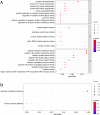Construction of an individualized clinical prognostic index based on ubiquitination-associated lncRNA in clear cell renal cell carcinoma patients
- PMID: 35538487
- PMCID: PMC9087998
- DOI: 10.1186/s12957-022-02618-x
Construction of an individualized clinical prognostic index based on ubiquitination-associated lncRNA in clear cell renal cell carcinoma patients
Abstract
Background: ccRCC is considered as the main subtype of RCC, which accounted for sixth deadliest cancer worldwide. Recently, ubiquitination has been reported to be closely involved in the progression of tumore. The purpose of this study was to identify the ubiquitination-associated genes and co-expressed lncRNAs on the prognosis of clear cell renal cell carcinoma (ccRCC) patients.
Methods and patients: We downloaded 530 cases and the corresponding transcriptome profiling from The Cancer Genome Atlas (TCGA) database. We distinguished mRNA and lncRNA expression data from the transcriptome profiling and then extracted the expression of mRNAs that regulate protein ubiquitination. We obtained lncRNAs associated with protein ubiquitination regulation from the lncRNA data by gene co-expression analysis. Cox regression analysis of survival time, survival status, and lncRNA expression level was carried out, and a prognostic index (PI) was constructed.
Results: The PI was established based on 8 prognostic lncRNAs that regulate protein ubiquitination and distinguish the high-risk group patients from all patients. Multivariate analysis indicated that this PI was an individualized clinical prognostic factor for patients with ccRCC. Regarding clinical characteristics, a ubiquitination-associated clinical-prognostic index (UCPI), containing 8 ubiquitination-related lncRNAs and age, was established and tested with AUC of 0.80.
Conclusion: We established a UCPI containing 8 lncRNAs related to protein ubiquitination. This UCPI may become an appropriate model to predict the prognosis in ccRCC patients and guide clinicians to adjust the follow-up regimen.
Keywords: Bioinformatic analysis; Clear cell renal cell carcinoma; Clinical-prognostic index; Long noncoding RNA; Ubiquitination.
© 2022. The Author(s).
Conflict of interest statement
The authors declare that they have no competing interests.
Figures




Similar articles
-
Genome-wide screening and cohorts validation identifying novel lncRNAs as prognostic biomarkers for clear cell renal cell carcinoma.J Cell Biochem. 2020 Mar;121(3):2559-2570. doi: 10.1002/jcb.29478. Epub 2019 Oct 23. J Cell Biochem. 2020. PMID: 31646670
-
Identification of a glycolysis-related lncRNA prognostic signature for clear cell renal cell carcinoma.Biosci Rep. 2021 Aug 27;41(8):BSR20211451. doi: 10.1042/BSR20211451. Biosci Rep. 2021. PMID: 34402862 Free PMC article.
-
Construction of a Novel Immune-Related lncRNA Pair Signature with Prognostic Significance for Kidney Clear Cell Renal Cell Carcinoma.Dis Markers. 2021 Sep 1;2021:8800358. doi: 10.1155/2021/8800358. eCollection 2021. Dis Markers. 2021. PMID: 34512816 Free PMC article.
-
Prognosis of clear cell renal cell carcinoma (ccRCC) based on a six-lncRNA-based risk score: an investigation based on RNA-sequencing data.J Transl Med. 2019 Aug 23;17(1):281. doi: 10.1186/s12967-019-2032-y. J Transl Med. 2019. PMID: 31443717 Free PMC article.
-
LncRNAs in the Regulation of Genes and Signaling Pathways through miRNA-Mediated and Other Mechanisms in Clear Cell Renal Cell Carcinoma.Int J Mol Sci. 2021 Oct 17;22(20):11193. doi: 10.3390/ijms222011193. Int J Mol Sci. 2021. PMID: 34681854 Free PMC article. Review.
Cited by
-
Development of a novel disulfidptosis-related lncRNA signature for prognostic and immune response prediction in clear cell renal cell carcinoma.Sci Rep. 2024 Jan 5;14(1):624. doi: 10.1038/s41598-024-51197-2. Sci Rep. 2024. PMID: 38182642 Free PMC article.
References
MeSH terms
Substances
LinkOut - more resources
Full Text Sources
Medical
Research Materials
Miscellaneous

